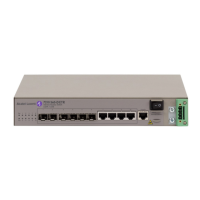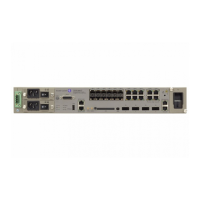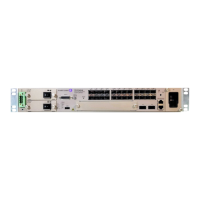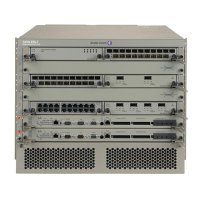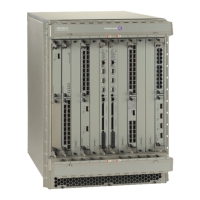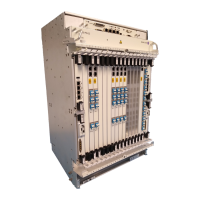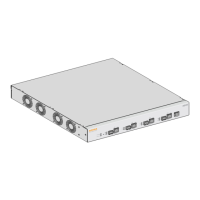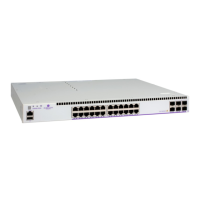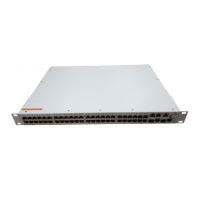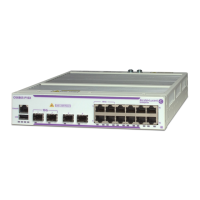Do you have a question about the Alcatel-Lucent 7210 and is the answer not in the manual?
Introduces the 7210 SAS-M switch and its available variants and features.
Explains the wire-speed, non-blocking switching fabric and full-duplex capability.
Details how to monitor and configure the switch using LEDs, CLI, and SNMP.
Lists key features like MPLS support, QoS, OAM, and hot-swappable modules.
Describes supported port types, including SFP, XFP, and Ethernet standards.
Provides a detailed overview of the physical components and ports on the front panel.
Outlines site requirements including temperature, humidity, and airflow for proper installation.
Details the necessary components to check after unpacking the switch before installation.
Covers procedures for rack mounting and desktop/shelf mounting of the switch.
Explains the critical steps for properly grounding the switch chassis for safety and performance.
Provides instructions for connecting AC and DC power supplies, including module specifications.
Guides users on establishing an out-of-band console connection for initial configuration.
Covers SFP/XFP handling, warnings, preparation, and installation/removal procedures.
Important safety precautions and handling guidelines for fiber optic transceivers.
Covers connector cleaning and details the various lock/release mechanisms for SFPs/XFPs.
Step-by-step instructions for both inserting and removing SFP/XFP transceivers.
Procedures for checking the post-installation status using system LEDs.
Covers the initial boot process and software loading procedures.
Steps to copy the TiMOS software image from an FTP server to the device's flash memory.
Guides on establishing console and Telnet connections for device access.
Detailed steps to establish a console connection using terminal emulation software.
Guides on configuring an IP interface and establishing a Telnet connection for remote access.
Explains how to interpret panel indicators (LEDs) to identify and troubleshoot problems.
Addresses issues related to the power supply not turning on or unexpected shutdowns due to cooling.
General advice on verifying component installation and testing in an alternate environment.
Troubleshooting tips for establishing network access via Telnet or management software.
Lists physical, environmental, and input specifications for the 7210 SAS-M.
Details compliance with VCCI, RoHS, and WEEE regulations.
Details the pinout for the 10/100BASE-TX MDI and MDI-X management port.
Provides the pin assignments for the RJ-45 serial console port.
Explains the pinouts for the DB-15 alarm interface connector and alarm inputs.
Introduces the 7210 SAS-M switch and its available variants and features.
Explains the wire-speed, non-blocking switching fabric and full-duplex capability.
Details how to monitor and configure the switch using LEDs, CLI, and SNMP.
Lists key features like MPLS support, QoS, OAM, and hot-swappable modules.
Describes supported port types, including SFP, XFP, and Ethernet standards.
Provides a detailed overview of the physical components and ports on the front panel.
Outlines site requirements including temperature, humidity, and airflow for proper installation.
Details the necessary components to check after unpacking the switch before installation.
Covers procedures for rack mounting and desktop/shelf mounting of the switch.
Explains the critical steps for properly grounding the switch chassis for safety and performance.
Provides instructions for connecting AC and DC power supplies, including module specifications.
Guides users on establishing an out-of-band console connection for initial configuration.
Covers SFP/XFP handling, warnings, preparation, and installation/removal procedures.
Important safety precautions and handling guidelines for fiber optic transceivers.
Covers connector cleaning and details the various lock/release mechanisms for SFPs/XFPs.
Step-by-step instructions for both inserting and removing SFP/XFP transceivers.
Procedures for checking the post-installation status using system LEDs.
Covers the initial boot process and software loading procedures.
Steps to copy the TiMOS software image from an FTP server to the device's flash memory.
Guides on establishing console and Telnet connections for device access.
Detailed steps to establish a console connection using terminal emulation software.
Guides on configuring an IP interface and establishing a Telnet connection for remote access.
Explains how to interpret panel indicators (LEDs) to identify and troubleshoot problems.
Addresses issues related to the power supply not turning on or unexpected shutdowns due to cooling.
General advice on verifying component installation and testing in an alternate environment.
Troubleshooting tips for establishing network access via Telnet or management software.
Lists physical, environmental, and input specifications for the 7210 SAS-M.
Details compliance with VCCI, RoHS, and WEEE regulations.
Details the pinout for the 10/100BASE-TX MDI and MDI-X management port.
Provides the pin assignments for the RJ-45 serial console port.
Explains the pinouts for the DB-15 alarm interface connector and alarm inputs.
| Product Type | Switch |
|---|---|
| Product Family | Service Access Switch |
| Form Factor | Varies by model (e.g., 1U, 2U, or modular) |
| Operating Temperature | 32°F to 104°F (0°C to 40°C) |
| Management | CLI, SNMP, Web-based GUI |
| Model | 7210 SAS-M |
| Power Supply | Redundant AC or DC power supplies |
